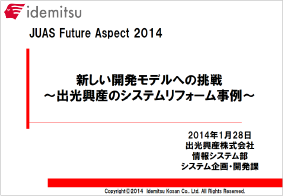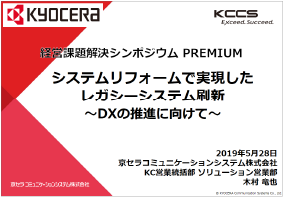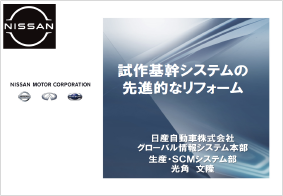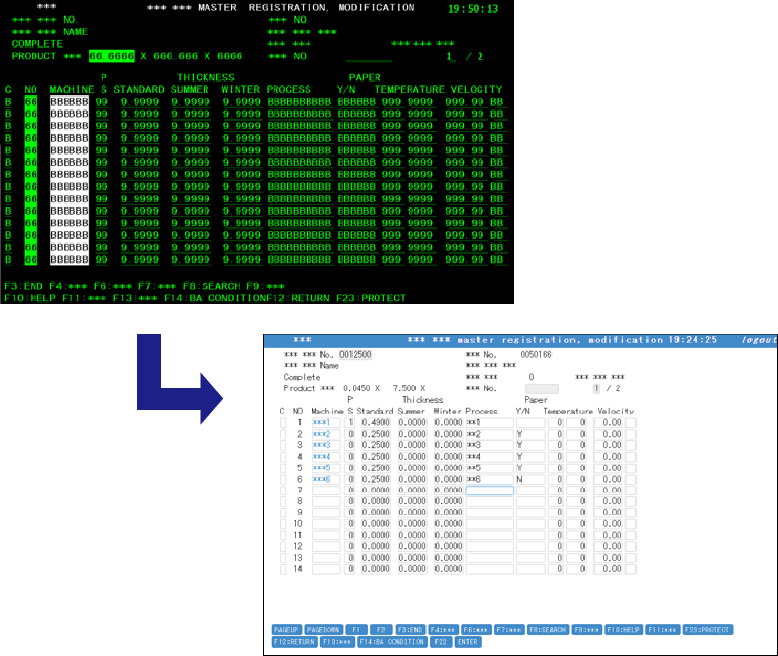
- Migration Pattern
- COBOL to Java/OpenCOBOL migration
migration-pattern
Migration Pattern
Success Stories
With our unparalleled AI modernization technology, we deliver a genuine open system with high quality and low costs, which sets us apart from the competition.
Several clients presented case studies at large IT events.

Simultaneous migration of 6 systems on 2 IBM mainframes within a short timeframe.
in BSIA Symposium
IBM mainframe Modernization
COBOL to MF COBOL/Java
JCL to Java + XML
Natural to Java
PL/I to MF PL/I
ADABAS to SQL Server

Mazda talks about migration cases
The mainstream of system innovation: AppModernizer
in Gatner Symposium
NEC mainframe Modernization
COBOL to Java
COBOL/S to Java
IDLⅡ to Java
JCL to Kshell
ADBS/RIQS to Oracle

Mainframe Modernization Initiatives
in JUAS Square
Fujitsu mainframe Modernization
MED/PSAM to HTML
COBOL to Java
JCL to Java+xml
AIM/DB to SQL Server

A new development model
Idemitsu Kosan’s AppModernizer case study
in JUAS Future Aspect
Fujitsu mainframe Modernization
YPS/COBOL to NetCOBOL
Natural to Java/NetCOBOL
JCL to Bshell
ADABAS to Oracle

Legacy system renewal achieved through AppModernizer
in Nikkei BP IT Modernization Summit
NEC mainframe & Peripheral Old Open System
COBOL/S to Java
COBOL to MF COBOL
JCL to Kshell
RDB, VSAS to PostgreSQL

Advanced migration of prototype core systems
in Gartner Application summit
IBM mainframe Modernization
PL/I to MF PL/I
JCL to MF JCL
ASM to MF PL/I
IMS DB to IMS DB for MF Enterprise Server
Problems with Holding on to the Mainframe
Trapped in a world of legacy, both companies and individuals lose their competitiveness.
Sooner or later, legacy systems will be modernized. Holding on to it means low usability and high operating costs. It also makes it difficult to apply new technologies such as generative AI, etc.
COBOL Migration Options and Pitfalls
A package that fits the business needs could be a good choice.
100% automated, AI-powered migration delivers a pure Java system at a dramatically lower cost, with high quality and short delivery time.
It turns into a monster that replicates nearly all legacy code and data issues using Java. This makes it even harder to maintain than existing systems—and even more difficult to update, as it requires deep knowledge of both legacy and open systems.
With limited training data and dynamic conversion rules, it is not practical.
Extremely high cost, long delivery time and high risk.
Slightly improved legacy data structure and readability.
Use special middleware to recreate legacy environments and extend the life of systems.
Problems of Straight Conversion
Straight conversion simply replaces legacy grammar by Java functions/classes.
The new Java system replicates the behavior of the legacy one, so it operates in a strange way. In the meantime, the legacy structure built with Java is highly complex.
Engineers need to understand both COBOL and Java.
Data analysis and modifications using AI are difficult.
Legacy data structure remains.
Data analysis becomes more difficult.

Many problems are left unresolved.
Prone to performance degradation due to legacy structure.
Dependent on customer-provided test data only. Further testing after integration testing is left with customer.
Features of AppModernizer’s Automatic Conversion

With over 10 years of experience and 850 successful migrations, our Al-powered conversion sets us apart from competitors, generates pure Java system automatically, and guarantees high quality at a low cost.
Testing Tools Covering All Migration Technical Points

Our AI-powered testing sets us apart from competitors, achieving high quality and reducing man-hours by leveraging both customer-provided test data and independently identifying key technical points.
Comparison Test through Reproducing Actual Processing
Reliable quality is achieved after data from many business days has been tested. We complete our tests only when data from 3 consecutive business days has been processed without any bugs.

With our testing, you can have peace of mind without having to worry about complex system tests yourself.
UI migration

Feature of migrated GUI
・Improved operability with mouse and buttons.
・Customizable according to customer UI standards.
・Response speed similar to that of web systems.
COBOL to OpenCOBOL
When modernizing a legacy COBOL system, if the budget is limited and only a few future modifications are expected, OpenCOBOL may be a suitable option.
We leverage our No.1 AI technology to understand COBOL systems to achieve nearly 100% automated conversion and rigorous testing. This approach eliminates common migration issues such as manual conversion of utilities and special items, performance degradation, and reliance solely on customer-provided test data for quality assurance.
Production Data Migration
If there are errors in data migration, business operation issues may arise.
Key implementation items
Over- or under-inclusion
All the data and operation patterns are rigorously checked by SoftRoad’s proprietary tool.
Data migration accuracy
We use the data migration tool to transform data across all test cases and validate the results through comparison.
Especially with the comprehensive testing, which spans a vast volume of data, we ensure the accuracy of structural changes, format conversions, etc.
Key tasks in data migration

Data migration was carried out in most of 850+ system migrations we have completed. All cases are successful.
Implement Specification Changes During Migration
Prolonged system freezes during migration can be avoided using our catch-up solution.
AppModernizer can achieve almost 100% automated conversion. If customer provides the latest source code after each update, we can incorporate the changes by quickly converting them into target language.

Migration cases
Multiple management systems for production, sales, export, after-slaes service, etc., running on mainframes
- Development process
- Inventory, migration design, source code migration – system test, user acceptance test support, go-live
- Migration information
- COBOL to Java
COBOL to MF COBOL
NATURAL to Java
PL/I to MF PL/I
JCL to Java+XML file
ASM to MF COBOL
ADABAS to SQL Server
OS/390 V2 to Windows Server 2012 - Current system scale
- COBOL:2,487KL, JCL:545KL, NATURAL:429KL, PL/I:2,156KL, ASM:35KL, Form:781, Screen:1,572
- Development period
- 20 months(* Migration of each system was carried out in about one year.)
Manufacturing system
- Development process
- Inventory, migration design, specification documentation, UI design – migration test, system test & user acceptance test support
- Migration information
- COBOL to Java
PL/I to Java
JCL to Shell
VSAM to Oracle
host to Linux - Current system scale
- COBOL:141.5KL, PL/I:37.2KL, JCL:44.8KL
- Development period
- 13 months
New core accounting system
- Development process
- Inventory, migration design, source code migration – migration test, functional modification, system test, user acceptance test support, go-live
- Migration information
- MED, PSAM to HTML5.0
COBOL to Java11
ASM, Utility to Java11
JCL, Macro, CLIST to Java11 & XML file
File(PS, DAM, PO) to Linux standard file
VSAM file to SQL Server 2019
XSP to Red Hat Enterprise Linux 8.4(AWS) - Current system scale
- MED, MAP:11.9KL, COBOL:1,934.2KL, JCL:751.3KL, ASM:3.8KL, CLIST:1.7KL, COPY:41.7KL, Utility:50, Macro:4KL
- Development period
- 30 months
Aggregation processing system
- Development process
- Inventory, migration design, source code migration – migration test, system test & user acceptance test support, go-live support
- Migration information
- IDLⅡ, COBOL, COBOLS, HPL to Java
JCL to Java & XML file
ADBS/RIQS to SQL Server 2016
ACOS4 to Windows Server 2016 - Current system scale
- IDLⅡ:775.9KL, COBOL:386.8KL, COBOLS:49KL, HPL:9.8KL, JCL:327.3KL
- Development period
- 36 months
Residential rental management system
- Development process
- Inventory, migration design, source code migration – migration test, system test & user acceptance test support
- Migration information
- YPS COBOL to Java
ASM to Java
NDB & RDB & VSAM to Oracle 12c
Fujitsu host to RHEL6 - Current system scale
- COBOL:520KL, ASM:0.9KL, JCL:178.5KL
- Development period
- 11 months
Cost management system
- Development process
- Inventory, migration design, specification documentation, source code migration – migration test, system test & user acceptance test support
- Migration information
- COBOL, COBOLS, COBOLX, IDLⅡ, RPG, Macro to Java
JCL to KShell
ADBS to Oracle
VSAS/RIQS to Oracle
ACOS4 to Linux - Current system scale
- COBOL:104.3KL, COBOLS:124.5KL, COBOLX:7.7KL, DATASSF:5.0KL, IDLⅡ:391.1KL, RPG:1.4KL, JCL:431.5KL, Macro:10KL
- Development period
- 20 months (* POC included)
CONTACT
For more details about system migration,
feel free to reach out to us.



